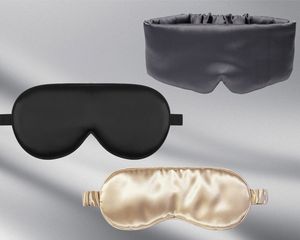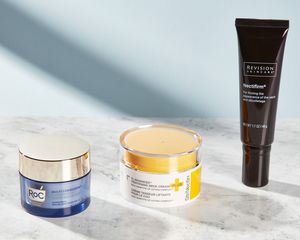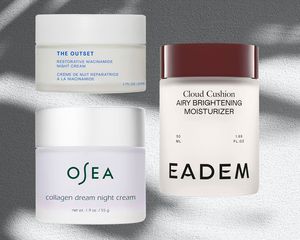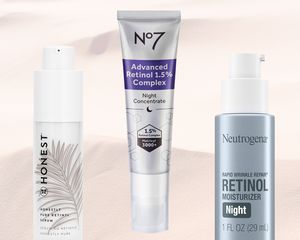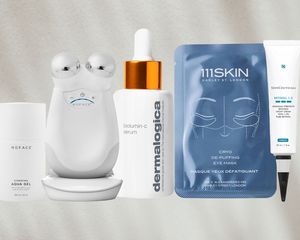:max_bytes(150000):strip_icc()/how-to-prevent-sleep-wrinkles-4693430-V1-70f9d02b6be744afbbfa41132bb9a7fd-f343b3e4bec14ee088ddf40273fab5b5.jpg)
Getty Images / Design by Camden Dechert
Waking up refreshed and energized is indicative of a good night's sleep. Unfortunately, so is "pillow face"—aka creases and folds from the position in which you slept the night before. While we experience this at any age, over time, you may come to realize that those very same markings crop up as real wrinkles.
"Sleep wrinkles are creases that form on the face due to skin positioning and pressure," explains dermatologist Dr. Rachel Nazarian. "They typically form as people move around in their sleep, sleeping with their face down or pressed up against their pillows, and primarily when fabrics have higher friction forces and the skin cannot glide along the fabric."
At some point, sleep wrinkles will become splayed across your face for more than just the few minutes it used to take to watch them fade away. According to our experts, there are behavioral changes you can make starting right now.
"This may come as a surprise, but did you know the second cause of wrinkles is sleeping?" says celebrity esthetician Renée Rouleau. "After sunlight and UV exposure, squishing your face into a pillow for approximately 2500 hours per year is like ironing wrinkles into the skin."
We asked Nazarian, Rouleau, and dermatologist Dr. Hadley King to share their recommendations for preventing and treating sleep lines.
Meet the Expert
- Rachel Nazarian, MD, FAAD, is a board-certified dermatologist at Schweiger Dermatology Group in New York.
- Hadley King, MD, is a board-certified dermatologist specializing in medical and cosmetic dermatology.
- Renée Rouleau is a celebrity esthetician and founder of her eponymous skincare line.
Keep reading to find out what you can do to prevent sleep lines and keep wrinkles at bay.
Swap Out Your Pillowcase
A common mistake is using pillowcases with fabrics that grip skin rather than allowing it to slide across it, notes Nazarian. While flannel and jersey sheets are cozy, they tend to hold onto your skin more than other fabrics do.
"Minimizing friction forces on the skin, so the fabric on your pillow and sheets don't pull and drag on the skin, can be quite useful," Nazarian says. "Instead, smoother 'silkier' sheets like satin and silk are less likely to grip skin and fold it, instead encouraging less pressure and more 'flow' of skin across its surface."
The less your skin grips onto your pillowcase, the less likely it is you'll wind up with permanent fine lines from your sleeping position. We like this set of two from Mommesilk—it's 22 momme (meaning, it's made with a high amount of silk) and comes in five gorgeous hues.
Sleep On Your Back
"Sleeping face down and pushing skin into the sheets or pillowcases causes the skin to fold and crease and eventually stay [that way] permanently, over time," says Nazarian. While it may be difficult to change your sleeping position, sleeping on your back allows for a fresh face come morning. Nurse Jamie's Beauty Bear Age Defy Memory Foam Pillow is made of silky-smooth satin and has a U-shaped design to conform to the contours of your face and neck. The result is crease-, wrinkle-, and worry-free sleep.
Avoid Sleeping on Your Hands
"Another common mistake is sleeping with your hands pressed against your face," says Nazarian. "Much like flannel or thicker cotton sheets, our skin grips rougher surfaces and wrinkles with lateral pressure. It's best for facial skin to avoid contact with other surfaces during sleep, keeping your face and head elevated with a pillow and using a silky cover that minimizes the pulling and rubbing on the skin."
If you're someone who often sleeps with their hands tucked under their face, try keeping your hands under your pillow rather than directly on your skin. This can help reduce friction while hopefully keeping you comfortable.
Byrdie Tip
Sleeping on your hands can also lend to breakouts as the oils on your hands can easily transfer to your face, causing bouts of acne while you sleep. If you tend to sleep this way, be sure to wash your hands before bed and practice a good nighttime skincare routine.
Use an Elevated Pillow
"Try to sleep with your head elevated on a pillow," Nazarian reiterates. If this is a challenge for you, opt for an adjustable pillow like Sleepgram's Sleeping Loft Soft Pillow. It comes with inserts that you can add or remove to reach the perfect elevation.
Try a Firm Pillow
"For a side sleeper, make sure to sleep with an extra-firm pillow and strategically position your head so the lower half of your face is literally off the pillow. Therefore, the face doesn't flatten out like a pancake," Rouleau suggests.
Wear a Sleep Mask
If you don't want to commit to a silk pillowcase, try a silk sleep mask instead. "Nighttime masks do a good job of keeping skin in place while you sleep, so even if there is a lot of pressure, the skin does not fold on itself," says Nazarian.
We're fans of Slip's Silk Sleepmask because it's gentle, doesn't tug on the delicate eye area, and feels plush on the skin. It's also easy to travel with, ensuring that you have restful, wrinkle-free sleep even on the go.
Massage Your Face
A good facial massage will not only help remove sleep lines, it also increases blood flow and circulation, which helps to boost collagen and plump up your face. Don't pull too hard on your face and incorporate a good moisturizer or serum as you massage. This is best done before you apply your makeup for the day, as you'll want as smooth a canvas as possible.
Stimulate Collagen Production to Minimize Creases
"Stimulating more collagen can help minimize these creases," suggests Nazarian. "This can be done with microneedling, various lasers (including Fraxel), and products." If you're unfamiliar, microneedling works to boost collagen production by creating tiny punctures in your skin. These spots serve as entry points for any products you put on your skin after. Plus, the small holes signal to your body that it needs to boost collagen production to heal them, filling in fine lines.
Use a Chemical Peel to Reduce Wrinkles
If you're having trouble getting used to sleeping differently, chemical peels can act as a buffer to ward off wrinkles. "Chemical peels do a wonderful job of resurfacing skin and minimizing the appearance of wrinkles while you get into the habit of changing some of your sleep patterns," says Nazarian. "It's never too late to improve your sleeping behavior, especially if it'll benefit your skin." The Dr. Dennis Gross Extra Strength Alpha Beta Peel is formulated with a blend of glycolic, lactic, and salicylic acid to not only stimulate collagen production, but boost cell turnover, improve the look of dark spots, and smooth out uneven texture.
Try Green Tea Bags
The anti-inflammatory and antioxidant properties found in green tea can help stimulate your skin's healing powers, aiding in clearer, smoother skin. For those who are acne-prone or have fine lines and wrinkles, green tea can help to reduce and plump your skin. Take two cold green tea bags and rest them on your eyes and face for a few minutes several times a week.
Slow Down Aging With SPF
If you're not already in the habit of wearing SPF daily, let this be your (final) reminder. "The best way to prevent wrinkles is wearing an SPF every day," Rouleau notes. "Hands down, daily use of sunscreen is the number one most effective way to slow down the skin aging process. A generous application each morning will dramatically reduce the formation of lines, wrinkles, and brown spots." Go for a broad-spectrum SPF of at least 30. Ghost Democracy's Lightweight Daily Face Sunscreen is SPF 33 and 100 percent mineral but doesn't leave behind a greasy residue, white cast, or chalky finish.
Byrdie Tip
The rule of thumb for SPF application is about one teaspoon of product for your face and roughly two tablespoons (about a shot glass) for your exposed body.
Choose Your Nighttime Products Mindfully
When you sleep, your skin is in repair mode, fixing all of the day's damage (think: pollution and sun exposure). The products you use pre-bedtime can make a real difference in the health of your overall complexion. "From a topical standpoint, look for an overnight serum formulated with the best ingredients your skin needs to repair while you sleep," Rouleau suggests. She says to look for microalgae, superfruits, and peptides, which improve firmness and help combat the daily effects of stress and pollution. Ranavat's Brightening Saffron Serum has been dubbed the "miracle elixir" in Ayurveda for its rich blend of superfoods, including saffron threads, which promote a bright, radiant complexion.
Use Retinol
If you don't already use retinol, you should consider incorporating it into your skincare routine as it can minimize fine lines and wrinkles. As a vitamin A derivative, retinol can also increase collagen production and increase skin elasticity, plumping skin to smooth out those sleep lines.
However, Nazarian cautions those who want to begin a retinol regimen, as it is a gradual process. She recommends trying niacinamide, which can decrease the irritation and dryness caused by retinoids and can help improve the skin barrier- making it less likely to get inflamed.
"This is a good product for most people, but I want to highlight it especially for those people with sensitive skin who are looking to start a retinol and are nervous about irritation," she says. "This may be an easier and slightly gentler way to introduce it into your regimen. I would recommend using it in the evening, due to retinol's instability in sunlight."
Use Silicone Pads
"Silicone pads are a good non-invasive option for getting rid of sleep lines resulting from facial expressions or from folding of the skin during sleep – Wrinkles Schminkles makes a great silicone pad," notes Dr. Hadley King. "These pads reduce transepidermal water loss and lock in moisture so the skin is better hydrated in order to repair and produce collagen. These are also great for the nighttime because they keep the skin flat during sleep, preventing skin creases."
Nazarian concurs, saying: "Whether they’re used on chest wrinkles or facial lines, they offer resistance against the folding of skin on itself and can improve and prevent lines with continued use."


